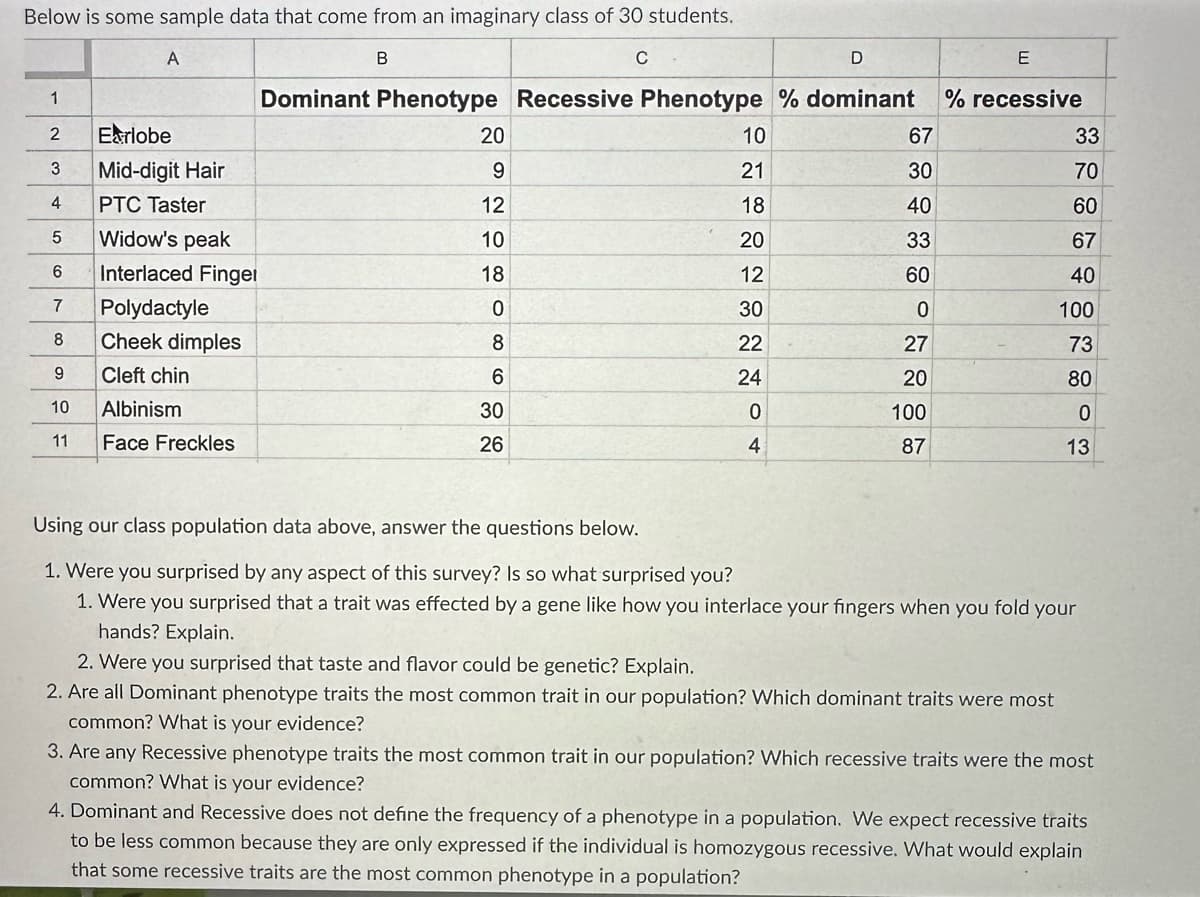Using our class population data above, answer the questions below. 1. Were you surprised by any aspect of this survey? Is so what surprised you? 1. Were you surprised that a trait was effected by a gene like how you interlace your fingers when you fold your hands? Explain. 2. Were you surprised that taste and flavor could be genetic? Explain. 2. Are all Dominant phenotype traits the most common trait in our population? Which dominant traits were most common? What is your evidence? 3. Are any Recessive phenotype traits the most common trait in our population? Which recessive traits were the most common? What is your evidence? 4. Dominant and Recessive does not define the frequency of a phenotype in a population. We expect recessive traits to be less common because they are only expressed if the individual is homozygous recessive. What would explain that some recessive traits are the most common phenotype in a population?
Using our class population data above, answer the questions below. 1. Were you surprised by any aspect of this survey? Is so what surprised you? 1. Were you surprised that a trait was effected by a gene like how you interlace your fingers when you fold your hands? Explain. 2. Were you surprised that taste and flavor could be genetic? Explain. 2. Are all Dominant phenotype traits the most common trait in our population? Which dominant traits were most common? What is your evidence? 3. Are any Recessive phenotype traits the most common trait in our population? Which recessive traits were the most common? What is your evidence? 4. Dominant and Recessive does not define the frequency of a phenotype in a population. We expect recessive traits to be less common because they are only expressed if the individual is homozygous recessive. What would explain that some recessive traits are the most common phenotype in a population?
Human Anatomy & Physiology (11th Edition)
11th Edition
ISBN:9780134580999
Author:Elaine N. Marieb, Katja N. Hoehn
Publisher:Elaine N. Marieb, Katja N. Hoehn
Chapter1: The Human Body: An Orientation
Section: Chapter Questions
Problem 1RQ: The correct sequence of levels forming the structural hierarchy is A. (a) organ, organ system,...
Related questions
Topic Video
Question
Using the data, answer ALL 4 questions. Specifically for 2 and 3, go into detail and be sure to discuss what your evidence is for the answers. Be detailed on every question.

Transcribed Image Text:Below is some sample data that come from an imaginary class of 30 students.
A
1
2
Earlobe
3 Mid-digit Hair
4
PTC Taster
5 Widow's peak
6
7
8
9
10
11
Interlaced Fingel
Polydactyle
Cheek dimples
Cleft chin
Albinism
Face Freckles
E
Dominant Phenotype Recessive Phenotype % dominant % recessive
B
20
9
12
10
18
0
8
6
30
26
10
21
18
20
12
30
22
24
0
4
D
67
30
40
33
60
0
27
20
100
87
33
70
60
67
40
100
73
80
0
13
Using our class population data above, answer the questions below.
1. Were you surprised by any aspect of this survey? Is so what surprised you?
1. Were you surprised that a trait was effected by a gene like how you interlace your fingers when you fold your
hands? Explain.
2. Were you surprised that taste and flavor could be genetic? Explain.
2. Are all Dominant phenotype traits the most common trait in our population? Which dominant traits were most
common? What is your evidence?
3. Are any Recessive phenotype traits the most common trait in our population? Which recessive traits were the most
common? What is your evidence?
4. Dominant and Recessive does not define the frequency of a phenotype in a population. We expect recessive traits
to be less common because they are only expressed if the individual is homozygous recessive. What would explain
that some recessive traits are the most common phenotype in a population?
Expert Solution
This question has been solved!
Explore an expertly crafted, step-by-step solution for a thorough understanding of key concepts.
Step by step
Solved in 3 steps

Knowledge Booster
Learn more about
Need a deep-dive on the concept behind this application? Look no further. Learn more about this topic, biology and related others by exploring similar questions and additional content below.Recommended textbooks for you

Human Anatomy & Physiology (11th Edition)
Biology
ISBN:
9780134580999
Author:
Elaine N. Marieb, Katja N. Hoehn
Publisher:
PEARSON

Biology 2e
Biology
ISBN:
9781947172517
Author:
Matthew Douglas, Jung Choi, Mary Ann Clark
Publisher:
OpenStax

Anatomy & Physiology
Biology
ISBN:
9781259398629
Author:
McKinley, Michael P., O'loughlin, Valerie Dean, Bidle, Theresa Stouter
Publisher:
Mcgraw Hill Education,

Human Anatomy & Physiology (11th Edition)
Biology
ISBN:
9780134580999
Author:
Elaine N. Marieb, Katja N. Hoehn
Publisher:
PEARSON

Biology 2e
Biology
ISBN:
9781947172517
Author:
Matthew Douglas, Jung Choi, Mary Ann Clark
Publisher:
OpenStax

Anatomy & Physiology
Biology
ISBN:
9781259398629
Author:
McKinley, Michael P., O'loughlin, Valerie Dean, Bidle, Theresa Stouter
Publisher:
Mcgraw Hill Education,

Molecular Biology of the Cell (Sixth Edition)
Biology
ISBN:
9780815344322
Author:
Bruce Alberts, Alexander D. Johnson, Julian Lewis, David Morgan, Martin Raff, Keith Roberts, Peter Walter
Publisher:
W. W. Norton & Company

Laboratory Manual For Human Anatomy & Physiology
Biology
ISBN:
9781260159363
Author:
Martin, Terry R., Prentice-craver, Cynthia
Publisher:
McGraw-Hill Publishing Co.

Inquiry Into Life (16th Edition)
Biology
ISBN:
9781260231700
Author:
Sylvia S. Mader, Michael Windelspecht
Publisher:
McGraw Hill Education